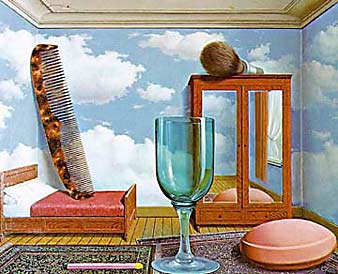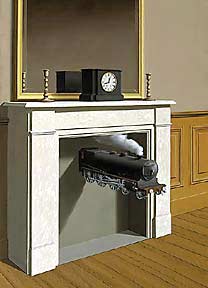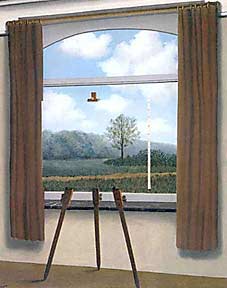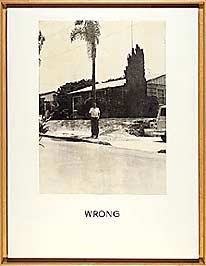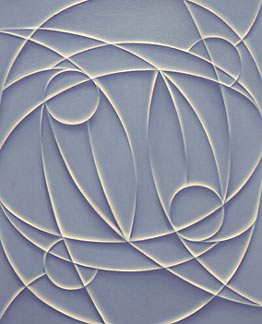[ UPDATE: This article has been revised, please see its closing for all the details ]Every movement whose time has come will experience steady growth and maturation, leading inevitably to splits and factions. Such is the case with the phenomenon of Stuckism, or the Remodernist movement, in the United States. American Remodernists have been formulating ideas, painting works under the banner of Stuckism, and founding chapters across the United States since 2000. The Los Angeles Stuckist Group mainly operates anonymously, and sees its role as providing the theoretical groundwork for the expansion of Remodernism in America. Since its inception the L.A. group has maintained a dynamic web log, and has provided links on its web site to other Stuckists and like-minded artists across the U.S.
While taking an activist approach to the promulgation of Remodernist philosophy, the L.A. Stuckist Group has assumed no leadership in the overall movement - nor do we seek such status. When it comes to group dynamics, we believe in autonomy, self-reliance, and democratic principles. We have never claimed to speak for anyone but ourselves, and proclaiming our circle as the preeminent Remodernist formation in the United States would be in contradiction to our vision of the movement. It should therefore come as no surprise that we would be in opposition to self-proclaimed leaders rising out of the shadows to anoint themselves the titular heads of the Remodernist movement in America. Careerists and opportunists who would exploit Remodernism to their own ends need to be challenged - the very scenario we are now confronted with and forced to respond to.
On Friday, December 13th, 2006, the self-appointed leader of "The American Stuckists", Allen Herndon, announced the launching of "the official website of the American Stuckists" (www.americanstuckism.com.) To our knowledge, Mr. Herndon has not had an active working relationship with any of the various working Remodernist groups and individuals across the U.S., nor did he consult with any of the aforementioned before stating publicly the establishment of his "American Stuckists" national movement.
"The American Stuckists" website is vaingloriously bedecked in red, white and blue, and bears a stupidly idyllic photograph of two children standing beneath the national banner of the United States - a photo that serves as the site’s masthead. Moreover, the site bears the motto "Home of the Cadmium Red, Titanium White, and Cerulean Blue" - as pugnacious a nationalistic slogan as ever existed. The site also boasts a red, white and blue logo that reads, "American Stuckism" - an emblem clearly modeled after the original Stuckist International logo that is smartly neutral when it comes to identifying national origin. While the founding London Stuckists are largely concerned with matters pertaining to the United Kingdom, they have prudently avoided crass displays of the Union Jack on their expansive website - which strives to present the international character of the Remodernist movement.
Mr. Herndon and his group have made an entry on the Wikipedia encyclopedia, proclaiming their red, white, and blue logo as the symbol of "The American Stuckists," giving the false impression that all Remodernists in the U.S. are united under their tutelage (Editor's Note: The Herndon group has since removed their Wikipedia entry.) The preponderance of red, white and blue on "The American Stuckists" website gives the appearance of an ultra-nationalist grouping rather than one dedicated to the universal language of art. Whether conscious or not, their misguided super-patriotism will not go unchallenged by us. National Chauvinism has absolutely no place in an international art movement.
Herndon wrote and posted a manifesto on the "The American Stuckists" website, allegedly meant to "unify the various Stuckist artists into a cohesive national movement." Notwithstanding the fact that no one elected him to coordinate such an undertaking, and putting aside for the moment the glaring contradiction of a so-called "national movement" having its manifesto penned by a single individual - Mr. Herndon makes a serious error in thinking Stuckism can, or should be, a "national movement" in the United States at all. Historically, late 20th Century national movements in art were at best closely aligned with right-wing ideology, like Thomas Hart Benton’s nativist school of reactionary American Regionalists (Benton declared himself an "enemy of modernism" in the 1920's.) Such is the nature of nationalism in developed Western countries. Nothing about Mr. Herndon’s red, white, and blue website gives the impression of his offering anything different.
Art fused with nationalism has always been a dangerous combination, and in the worst case scenarios, national movements in art found their most terrifying political expressions in the dictatorial regimes of 1930’s Spain, Italy, and Germany. The legacy of the lethal mix of art and nationalism in the late 20th Century is so strong, that even the mere suggestion of a "national movement" in art raises suspicions and fears. We wish to distance ourselves and Remodernism from any such expression. It is one thing to be an admirer of, and adherent to, an international school of art like Impressionism, Remodernism, or Conceptualism - but it is perilous to suggest that a school of art can or should be claimed by any one nation.
Likewise, Mr. Herndon’s suggestion that "The Future of Western Art is up to you," could just have readily been made by the most retrograde Eurocentric traditionalist pining for a return to some golden yesteryear. The L.A. Stuckist Group understands the globalized nature of art in today’s world, what is more, we see that potential problems and their solutions must be international in scope. The future of Western art is of little importance to us - we are concerned with no less than the future of art itself.
In point number twenty of his manifesto, Mr. Herndon wrote;
"But we are not a political group; we are painters. You may hold any political belief you like and be a member. Politics destroyed the spiritual aspects of Surrealism. If you are a political painter that is fine, but we are not painting politicians."
It is astonishing that in describing "The American Stuckists" Mr. Herndon can write that "we are not a political group" - after having first wrapped himself in the American flag while calling for a national movement of U.S. artists. What a strange definition he has of what constitutes the political. Be that as it may, we’d like to remind Mr. Herndon that the primary objectives of the Remodernist movement consists of uprooting postmodern thought and institutions. That is no small undertaking, and the process in large part has been, and will continue to be, an intensely political one. An entrenched and powerful elite cannot be removed without a political struggle, and to think otherwise is pure naïveté.
The L.A. Stuckist Group is also in profound disagreement with Mr. Herndon’s open door policy when it comes to persons of any political persuasion being welcome in the Stuckist International. "The American Stuckists" of Mr. Herndon may embrace the pro-Bush radical right and its "culture wars" agenda - we do not. Our opposition to the postmodern art world elite is not based upon some conservative desire for a return to a mythic past, we wish a progressive way forward for painting, and putting traditionalists at the helm of our movement will only give it a reactionary character.
Mr. Herndon’s assertion that "Politics destroyed the spiritual aspects of Surrealism" is also patently false. Surrealism was a militant political and aesthetic response to bourgeois society as it crept towards its marriage to mass carnage and repression. Internal strife and political disagreement within Surrealist circles did not inhibit Surrealism’s ability to fulfill its mission - it was war and fascism that did that.
In closing, we sincerely hope that upon reading our critique, Mr. Herndon will abandon all intentions of dominating the North American section of the Stuckist/Remodernist International. He can of course publish whatever he likes, but if Mr. Herndon wishes to play a part in a genuine arts movement in the United States, he must first learn how to collaborate and cooperate with other artists on an equal basis. An immediate act of rapprochement should be taken on his part, indicating a willingness to shed his pretense at leadership. Such a statement of reconciliation would go a long way if it also contained an avowal to rein in and curtail the offensive nationalism we see as detrimental to a truly international movement.
[ Update: The L.A. Stuckist group received many positive responses to, Against National Chauvinism in Art, our critique lambasting "The American Stuckists." Our critical assessment apparently hastened the collapse of the group, since on December, 18th, 2006, it ceased publishing its web site - leaving only the following brief message from the organizers in its place:
"The intention of this site was to provide a central Internet hub in which any individual or group calling themselves Stuckist could display their artwork for free. It has met with opposition and criticism, and is thus permanently closed. Sincerest apologies for any misinterpretation or misunderstanding."
We are not in any way opposed to the establishment of a national hub website that will act as a clearing house for the many groups and individuals in the United States now associated with Remodernism. When the L.A. Stuckist group launched its own website on April 9, 2006, it was the co-founder of the London Stuckists, Charles Thomson, who suggested to us that our website serve as that hub. We declined that role, but in the interim have found ourselves moving inexorably towards it. We encourage all Stuckists and supporters of Remodernism in the U.S. to send us the web addresses of their groups or individual online portfolios. We’ll be more than happy to post this information in the
Stuckist Links section of our website.
